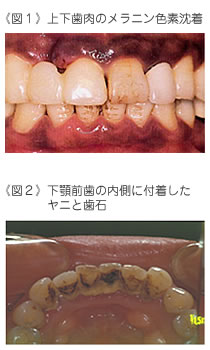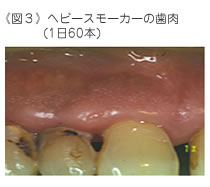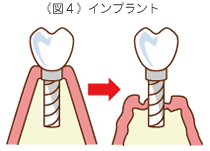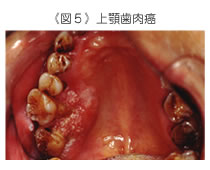Here's the text.
Oral health and tobacco
Last Updated March 28, 2024
Oral health and tobacco
Tobacco is the enemy of beauty = pigmentation on the gums and teeth, and also bad breath!

The mouth is the first organ that suffers from tobacco damage. Smoking causes darkening of the gingival of the front teeth and melanin pigmentation (Fig. 1). Even if you quit smoking, it will take several years to disappear. Tobacco tar (tar) is easily attached to the back of the teeth (Fig. 2) is not desirable for beauty.
In addition to tobacco odor, periodontal disease, smell of dirt on the surface of the tongue (black tongue), smell of sputum in the throat and bronchial sputum are mixed, and emits a strong bad breath.
Carbon monoxide exceeding the indoor environmental standard (10ppm) can be detected in the exhaled breath, which poses a threat to seizures to people with asthma.
People who smoke lose a lot of teeth due to periodontal disease!
Smokers are 2-8 times more susceptible to periodontal disease than those who do not smoke. It is called "smoking-related periodontal disease" and smoking cessation is essential. Periodontal disease health check-up results show that more smokers have severe periodontal disease (Table 1).
| Smokers | Non-smoker |
|---|---|
| 55.2% | 32.0% |
(Table 1) Periodontal Disease Test, Yokohama City in FY2011
Why does periodontal disease worsen?

The three major harmful substances of tobacco are tar, nicotine, and carbon monoxide. Poor periodontal disease bacteria in the periodontal pocket (groove between teeth and gums) dislike oxygen (anaerobic bacteria), so nicotine has poor blood flow due to vascular constriction due to nicotine, and the combination of carbon monoxide and hemoglobin causes oxygen deficiency and increases momentum. Even if you brush your teeth, destruction progresses from the inside of the periodontal tissue.
Heavy smokers have a hardened gingival surface (Fig. 3), and the bones that support the teeth are significantly absorbed, and many teeth are lost. Because signs of inflammation such as bleeding and redness are less likely to appear, the discovery of periodontal disease is delayed and becomes more severe without realizing it. Because high-heat tobacco smoke of about 700 ° C directly hits the inside of the jaw gums, periodontal disease is common in the front teeth and molars. It reduces the secretion of saliva, plaque (a mass of living bacteria) and tartar, and reduces the number of antibodies that fight pathogens in saliva, making it more susceptible to periodontal disease and cavity.
Smokers are badly cured!

Periodontal disease treatment
It has a bad healing effect and also has a low effect of antibacterial agent.
Implant treatment = artificial root
Blood flow disorders and inflammation occurs in the tissue around the implant (peri-implant flames), and the jaw bone may melt and fall off without being able to support the implant (Fig. 4).
Dry socket, after tooth extraction Myelitis
The wounds after tooth extraction are poorly cured, and the frequency of dry sockets that cause pain and infection, and myelitis increases.
If your parent is a smoker, what is your child's teeth? Passive smoking is scary!
Children who are unconsciously smoke tobacco smoke from their parents have more caries. It is thought that this is because the concentration of cotinine in the blood increases and the resistance to infection decreases. Passive smoking may also cause melanin pigmentation in children's gums.

Oral cancer
Tobacco contains carcinogens, and smokers take in carcinogens on a daily basis. It is said that cancer in the mouth and pharyngeal is three times more likely than in those who do not smoke (Fig. 5).
Recognition of "the relationship between tobacco and periodontal disease" is low!
Despite tobacco being the biggest risk factor for periodontal disease, it has a low awareness in Yokohama. The public awareness survey on health conducted every three years in Health and Social Welfare Bureau showed 24.7% in 2005, 27.3% in 2008, and 24.1% in 2011.

Let's stop smoking and make a wonderful smile!
The effect of smoking cessation is clear, and the blood flow of the gums recovers normally in a few days to weeks. Smoking cessation is the most effective way to prevent and treat oral diseases, including periodontal disease. Why don't you get back the spilling smile with smoking cessation?
Inquiries to this page
Health Promotion Division, Health and Social Welfare Bureau Community Welfare and Health Department
Telephone: 045-671-2454
Telephone: 045-671-2454
Fax: 045-663-4469
Email address: kf-jyudokituenboshi@city.yokohama.jp
Page ID: 176-631-637







